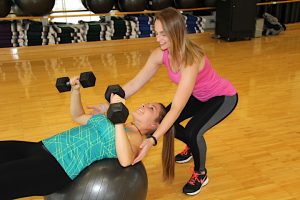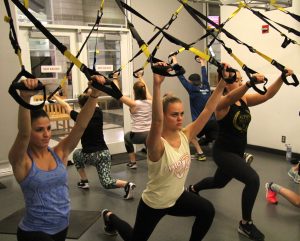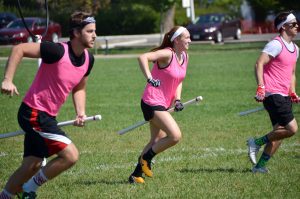
Shannon Speed
Start the new semester on the right foot! Shannon Speed explains different types of exercises that you can work on, as well as other recreational activities to keep you healthy and active. Shannon is one of the Miami Recreational Center’s Assistant Directors of Fitness, she is also a Certified Personal Trainer and Group Fitness instructor.
Cardiovascular Exercise vs. Weight Training
There are a variety of ways to participate in activities that challenge cardiovascular health. Things such as golfing, yard-work, and bowling are all technical forms of cardiovascular exercise. It is recommended to participate in cardiovascular activity 3-5 times per week at a moderate to vigorous intensity, for about 30 minutes. In total, you should be getting 150 minutes of cardiovascular exercise per week, but how you break it up is really up to the individual. For some people golfing may be vigorous enough to serve as an appropriate form of exercise. However, it’s more likely that college students will need to engage in activities like running, biking, basketball, or climbing stairs.
Weight training is also an important component of exercise. It is recommended to weight train 2-3 times per week, making sure to take rests between weight training days. The Recreation Center has a multitude of weight training machines, in addition to free weights. If you are just beginning with a weight training regimen, it can be daunting and the first few days may be a struggle, but it’s well worth it.
E ach have their own benefits. Cardiovascular exercise can reduce the risk of coronary heart disease, improves cardiovascular and respiratory function, and decreases anxiety. Weight training is known to improve bone density, decrease the risk of injury, and increase fat-free mass. Many people will choose to participate in either cardiovascular exercise or weight training, but the reality is that they are both most effective when combined. Both improve the overall quality of life and contribute to enhanced feelings of well-being and self-confidence.
ach have their own benefits. Cardiovascular exercise can reduce the risk of coronary heart disease, improves cardiovascular and respiratory function, and decreases anxiety. Weight training is known to improve bone density, decrease the risk of injury, and increase fat-free mass. Many people will choose to participate in either cardiovascular exercise or weight training, but the reality is that they are both most effective when combined. Both improve the overall quality of life and contribute to enhanced feelings of well-being and self-confidence.
Group Fitness vs. Personal Training

This is a long-standing battle for some as Group Fitness and Personal Training are complete opposites. Group Fitness in is a group setting of anywhere from 2 to 50 people and offers a variety of modes of exercise. For example, at the Recreation Center our offerings include: Pilates, Vinyasa Yoga, Ashtanga Yoga, Yoga Pilates, Barre, Spinning, Toning, Bootcamp, Tabata, Zumba®, Indo-Row®, Shockwave®, TRX®, SilverSneakers®, Kettlebell, Baby & Me Yoga, Kickboxing, Abs classes, Cardio classes, and a variety of classes with different combinations of those options. The downside is that Group Fitness isn’t as personalized. There are many instructors that cater toward regular participants, but there are no fitness assessments performed to monitor progress, and sometimes your favorite class is only available once a week.
Personal Training is personalized. A health assessment and profile is typically completed beforehand to gauge where to begin in the fitness program. You also have the capability of meeting with the trainer more than once per week. The downside is that you may not have the support of a group, and personal training may not be as entertaining for those that like the music and interaction with others. In some cases, there is a happy medium, and we do offer this option at the Rec Center.
Small Group Training isn’t a new form of fitness, but it’s not something that many people know about. In this setting of 2-5 people, you have the best of both worlds: a social network, and individualized attention. If you’re considering beginning a Group Fitness or Personal Training program, you should make sure you’re aware of all of your options so you can choose what’s best for you.
Informal vs Formal Recreation

Club Quidditch
Most people don’t understand the difference between these two forms of recreation because “formal” is often associated with staunch or uptight. However, the real difference is really whether or not you are participating in something organized or unorganized. Informal recreation is anything from going to the fitness center to run on the treadmill, to playing a pickup basketball game or climbing at the rock wall during open climbing hours.
Formal recreation, on the other hand, includes activities like participating in an intramural soccer game, training with a personal trainer, or going on an organized adventure trip. More often, formal recreation is performed with friends or a social network whereas informal recreation may be on your own. That said, both are forms of recreation and, as long as you are getting exercise, are great options.
Most of the time your choice between informal and formal recreation is based on a personal preference. Do you prefer to exercise on your own or do you prefer to exercise with others? Or maybe you’d rather do both? There’s nothing that says you can’t participate in both an intramural soccer game and run on the treadmill in the fitness center on your own.
By Shannon Speed



the best article
Marvelous, what a webpage it is! This blog gives
useful facts to us, keep it up.
Great article.